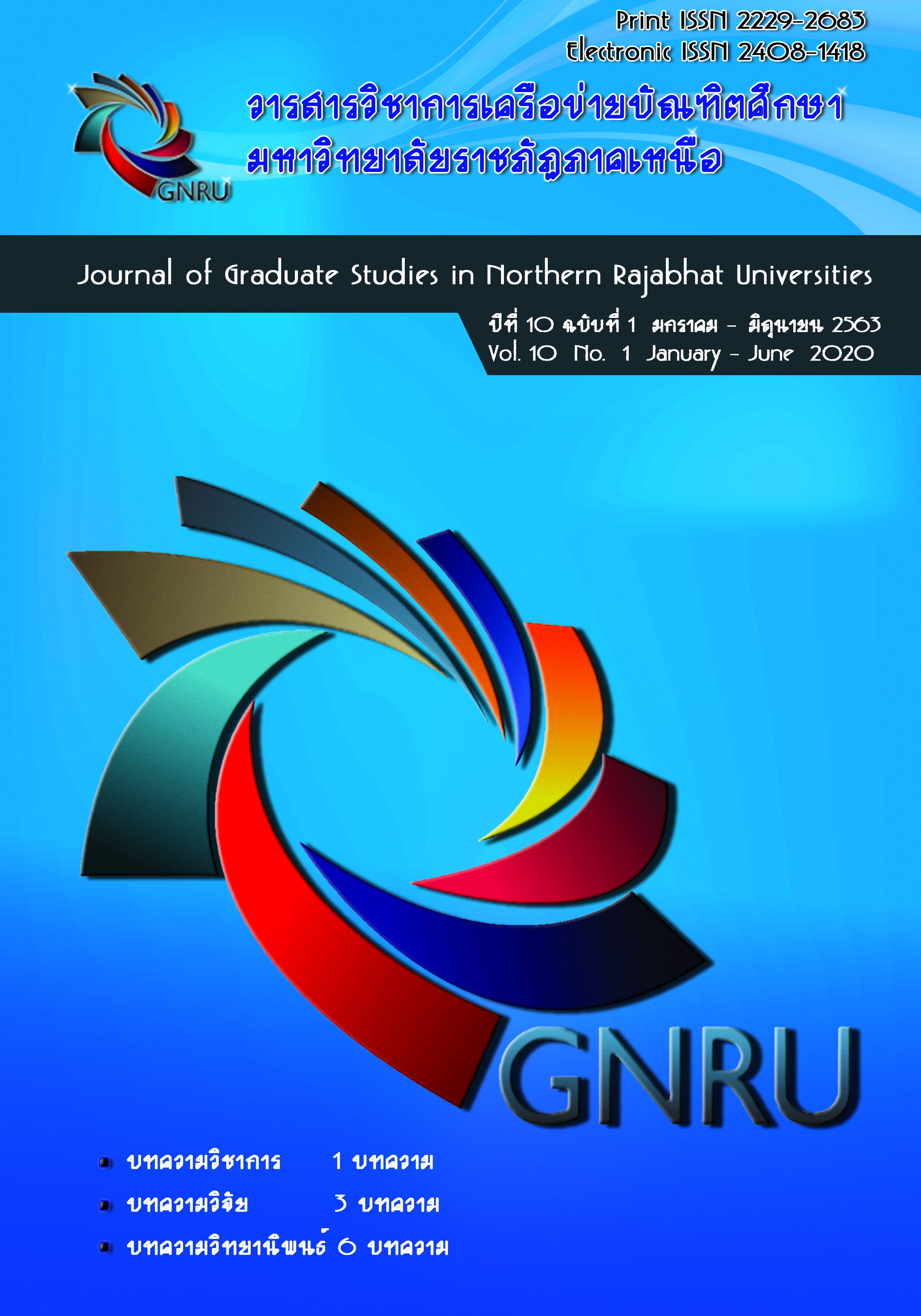การศึกษาคู่วัจนกรรมในการสนทนาในห้องเรียนที่จัดการเรียนการสอนโดยใช้ภาษาอังกฤษเป็นสื่อ A Study of Adjacency Pairs in Conversation in English Program Classrooms
Main Article Content
Abstract
การวิจัยครั้งนี้มีวัตถุประสงค์เพื่อ 1) ศึกษาประเภทของคู่วัจนกรรม 2) ศึกษาส่วนประกอบของคู่วัจนกรรมในห้องเรียนที่จัดการเรียนการสอนโดยใช้ภาษาอังกฤษเป็นสื่อ ดำเนินการเก็บข้อมูลโดยการสังเกตการสอนซึ่งเป็นการสังเกตแบบไม่มีส่วนร่วม (Non-participatory observation) และการบันทึกเสียงจากห้องเรียนที่จัดการเรียนการสอนโดยใช้ภาษาอังกฤษเป็นสื่อ จำนวน 20 ชั่วโมงโดยเก็บข้อมูลจากโรงเรียนรัฐบาล 1 แห่ง และโรงเรียนเอกชน 1 แห่ง ในระดับชั้นมัธยมศึกษาตอนปลาย ในปีการศึกษา 2560 จากนั้นจึงถ่ายเสียงบทสนทนาตามแนวคิดการวิเคราะห์บทสนทนา (Conversation Analysis) สถิติที่ใช้ในการวิจัยได้แก่ ค่าร้อยละและค่าเฉลี่ย
ผลการวิจัยพบว่า 1. ประเภทของคู่วัจนกรรมที่พบในการวิจัยครั้งนี้ ประกอบด้วยคู่วัจนกรรม 12 ประเภท ได้แก่ คู่วัจนกรรมการถาม-ตอบ การขอร้อง/ คำสั่ง การให้ข้อมูล การเรียกขาน การทักทาย การชมเชย การกล่าวลา การขอบคุณ การตำหนิ การขออนุญาต การขอโทษและการต่อรอง โดยพบคู่วัจนกรรมการถาม-ตอบ การขอร้อง/ คำสั่ง และการให้ข้อมูล-การตอบรับ มากที่สุดตามลำดับ 2. ส่วนประกอบของคู่วัจนกรรมที่พบในการวิจัยครั้งนี้ พบส่วนที่สองของคู่วัจนกรรมที่ไม่พึงประสงค์ในคู่วัจนกรรม 8 ประเภท ได้แก่ คู่วัจนกรรมการถาม-ตอบ การขอร้อง/ คำสั่ง การให้ข้อมูล การเรียกขาน การทักทาย การชมเชย การตำหนิ และการต่อรองและพบมากที่สุดในคู่วัจนกรรมการถาม-ตอบ การเรียกขานและการขอร้อง/ คำสั่ง ตามลำดับ
This research aimed to study 1) types of adjacency pairs and 2) parts of adjacency pairs appeared in English Program classrooms. The data was collected using non-participatory observation and 20-hour voice record from English Program classrooms in one private school and one public school in Bangkok. The notion of conversation analysis was used as a main theory in analyzing adjacency pairs found in this research. The statistics used for data analysis were percentage and mean.
The research results were as follows: 1) 12 types of adjacency pairs were found in this study. They were 1)question-answer, 2) asking or commanding, 3) informing, 4) summoning, 5) greeting, 6) appreciating, 7) leave-taking, 8) thanking, 9) blaming, 10) asking permission, 11) apologizing and 12) bargaining. adjacency pairs which were mostly found were question-answer, asking or commanding and informing-acknowledgement respectively. 2) The dispreferred second pair parts were found in eight types of adjacency pairs. They were 1) question-answer, 2) asking or commanding, 3) informing, 4) summoning, 5) greeting, 6) appreciating, 7) blaming, and 8) bargaining. The dispreferred second pair parts which were mostly found were question-answer, summoning and asking or commanding, respectively.
Article Details
References
กฤษดาวรรณ หงศ์ลดารมภ์ และ ธีรนุช โชคสุวณิช. (2551). วัจนปฏิบัติศาสตร์. กรุงเทพมหานคร: โครงการเผยแพร่ผลงานวิชาการ คณะอักษรศาสตร์ จุฬาลงกรณ์มหาวิทยาลัย.
จันทิมา อังคพณิชกิจ. (2561). การวิเคราะห์ข้อความ. กรุงเทพฯ: สำนักพิมพ์มหาวิทยาลัยธรรมศาสตร์.
ชลธิชา บำรุงรักษ์. (2539). การวิเคราะห์ภาษาระดับข้อความประเภทต่าง ๆในภาษาไทย. วิทยานิพนธ์ศิลปศาสตรมหาบัณฑิต สาขาวิชาภาษาศาสตร์, มหาวิทยาลัยธรรมศาสตร์.
วิศนี เครือวนิชกรกุล. (2546). การศึกษารูปแบบภาษานิยมในบทสนทนาไทย. วิทยานิพนธ์ศึกษาศาสตรมหาบัณฑิต สาขาวิชาภาษาศาสตร์, มหาวิทยาลัยมหิดล.
สถาบันทดสอบทางการศึกษาแห่งชาติ. 2559. NIETS NEWS 57: 8 (Online). http://www.niets.or.th/th/catalog/view/470, 20 สิงหาคม 2559.
สุมิตร สุวรรณ, นท. (2548). การวิจัยเชิงปริมาณและการวิจัยเชิงคุณภาพ (Online). http://rlc.nrct.go.th.ewt_dl.php?nid=900, 25 ตุลาคม 2562.
Dearden, J. (2014). English as a medium of instruction - a growing global phenomenon: phase 1. United Kingdom: British Council.
Goffman, E. (1981). Forms of talk. Philadelphia: University of Pennsylvania Press.
Graddol, D. (2006). English next. United Kingdom: British Council.
Intachakra, S. (2004). “Contrastive pragmatics and language teaching: apologies and thanks in English and Thai.” Regional Language Centre Journal 35(1): 37-62.
Kubota, R. (2001). “Discursive construction of the images of U.S. classrooms.”TESOL Quarterly 35(1): 9–38.
Kachru, B. B. (1985). Standards, codification and sociolinguistic realism: the English language in the outer circle. English in the world: teaching and learning the language and literatures, 11-30.
Kunci, K. (2012). A sociolinguistic analysis of adjacency pairs in the classroom scenes of freedom writers the movie (Online). http://journal.student.uny.ac.id/jurnal/artikel/1116/40/202, March 7, 2015.
Levinson, S.C. (1983). Pragmatics. Cambridge: Cambridge University Press.
Modehiran, P. (2005). Correction making among Thais and Americans: a study of cross-cultural and interlanguage pragmatics. Bangkok: Chulalongkorn University.
Naruemon, D., Pothisuwan, P., & Bhoomanee, C. (2019). “Question in English language classroom.” Journal of Graduate Studies in Northern Rajabhat Universities 9(1): 17-32.
Psathas, G. 1995. Conversation Analysis: The Study of Talk in Interaction. California: Sage Publications.
Sack, H. (1995). Lectures on conversation. Boston: Blackwell.
Sacks, H., Schegloff, E.A. & Jefferson, G. (1974). A simplest systematic for the organization turn-taking for conversation. New York: Academic Press.
Schegloff, E.A. (2007). Sequence organization in interaction. Cambridge: Cambridge University Press.
Thomas, J. (1983). “Cross-cultural pragmatic failure.” Applied Linguistic 4(2): 91-112.


